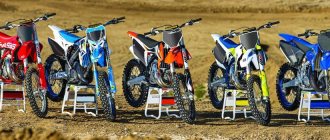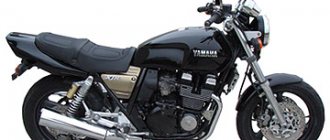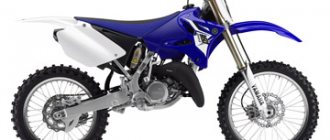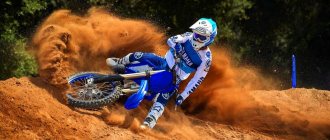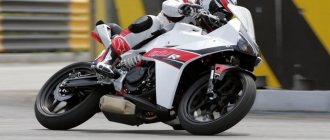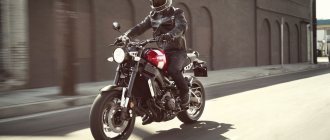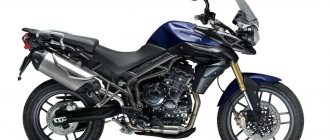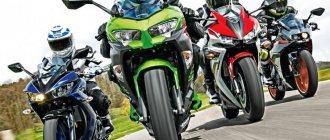Yamaha YZ125 2020 and KTM 125 SX 2020
Comparing dirt bikes is usually a competition. But today will be a little different. Yes, we will give you all the same facts as in the usual comparisons, but two-stroke 125s are in a completely different class.
The bottom line is this: 2t 250s, 4t 250s or 4t 450s are usually raced. Each of these motocross motorcycles competes in its own class, and each has a chance of winning. With 125 cc two-stroke bikes, things are different: there are practically no serious competitions on them, but this class of bikes is very much appreciated among amateurs.
Yamaha YZ125 and KTM 125 SX
The easiest way to find a two-stroke octagon is on the training track on Saturday, where beginners learn the intricacies of motocross or those who like to tickle their nerves take a break from everyday activities. However, recently in the USA championships have appeared purely for two-stroke bikes, where you can put your 125 against other “stinkers”. But in any case, two-stroke octagons are often ridden for fun or to feel nostalgic for the days of youth and two-stroke smoke (a special thrill is that you don’t have to carry a handful of candles in your mitten). That’s how the idea was born to compare two 125s: not as competitors in a race, but as two vacationers on a cross-country track. Not even two, but three, because in essence the KTM 125SX is not much different from the Husqvarna TC125.
Weight
Surprisingly, the weight of the Yamaha YZ125 and KTM 125 SX is stated quite reliably. Without fuel, but with other fluids, the Yamaha YZ125 weighs 91 kilograms, and the number on the scale coincides with that indicated in the specifications. The KTM 125SX, in turn, is slightly heavier than what is written in the brochure, but lighter than the Yamaha - 87.3 kg.
Note the 3+ kilograms difference. Even on a 450cc motocross bike, this is a significant figure that can be felt on the track, and as a result, the KTM 125SX hits the starting line as the lightest full-size motocross bike of 2021.
Yamaha YZ125 2020
Dyno stand
Judging by the graph, the Yamaha produces more horsepower from the 5,000 rpm where the 125cc engine starts, all the way up to 7,800 rpm. From 7,900 rpm to its peak at 11,500 rpm, the KTM 125SX outperforms the Yamaha YZ125 throughout this entire range. At peak, the KTM produces 37.5 horses and the YZ125 34.84. The difference is 2.66 hp in favor of KTM.
If you break the range down into smaller sections, starting at 6000 the Yamaha YZ125 produces half a horsepower more than the KTM from idle. At 7000, the Yamaha makes ¾ more horsepower than the KTM. Its advantage continues to 7800, where the YZ is still half a horse higher, but after 200 rpm, at 8000, the KTM 125SX is already producing ½ horse more. And then the trend continues: at 9000 the 125SX produces almost two horses more, at 10000 ½ horse more, at 11000 almost 3 horses more, and at its peak (11200) the KTM produces 37.5 horses when the Yamaha is at the same speed gives 34.5.
Traction
The Yamaha YZ125 and KTM 125 SX produce peak thrust at 11000 and 11100 respectively. The 125 SX produces 24 Nm, and the YZ125 produces a little over 22. Quite a significant difference in KTM's favor. At the same time, the YZ125 produces maximum torque up to 8000 rpm, and the KTM 125 SX - after 8000 rpm.
KTM 125 SX 2020
On the road
You don't need to be a rocket scientist to figure it out. All testers confirm that the KTM is incredibly fast at the peak of its power. On it, large jumps can be easily jumped into the receiver, but on the Yamaha YZ125 you constantly fall short. On big hills, the KTM 125SX allows you to turn its lack of bottom end into an advantage at the top. And on the long starting straights, KTM even outperforms Yamaha. So if you want the fastest production 125cc two-stroke, it's orange.
Is the Yamaha YZ125 that bad?
Not at all. Speed at the end of the straight is far from the most important thing in cross-country. And while the KTM 125SX is super-fast from 8,000 rpm, the Yamaha YZ125's traction is much more useful out of corners.
Where the KTM requires the clutch to work, the YZ125 shoots out of corners with a satisfying roar. And going faster in the first meters after a turn, the Yamaha YZ125 often gets such a head start that the KTM can no longer make up for. The YZ and KTM were compared lap after lap. The Yamaha YZ125 comes out of the corners faster, and the KTM overtakes it at the end of the straight. If the YZ125 was able to stay ahead, the KTM rider could end up making a mistake on the exit of the corner and would have to smoothly accelerate the Austrian.
The torquey nature of the KTM engine makes it impossible to make mistakes when releasing the gas. And what greatly reduces the pace on the 125SX, the YZ125 can easily forgive, and even if you miss the corner, it accelerates quickly, but the KTM 125SX does not.
Yamaha YZ125 and KTM 125SX Who has more fun?
Without a shadow of a doubt, the Yamaha YZ125 is much simpler and more fun thanks to its low-end traction. The KTM strains in tight corners and requires more refined riding technique where the Yamaha YZ125 delivers simply due to its friendlier bottom-end character.
Yamaha YZ125 2020
Pendants
The general consensus is that there is no comparison: Kayaba SSS versus KTM's WP XACT. Kayaba SSS suspensions have received top marks for 14 years. But don’t forget that these are just octagons; their low weight and low power by cross-country standards reduce the requirements for suspensions and neutralize their differences. This is probably why the difference between SSS and XACT on 125s is much less pronounced than on 250s and 450s. There are at least two factors at play here: First, the loads on the suspension components on the 91-kilogram, 35-horsepower YZ125 are significantly less than on the 108-kilogram, 58-horsepower Yamaha YZ450F (or its orange rival). And secondly, one of the significant disadvantages of spring forks is that changing the springs in them is quite a task. No one comes to a pit stop and says, “Hey guys, the springs are a little soft, change them quickly.”
At the same time, the air forks allow you to quickly adjust the stiffness. And we adjusted it more than once, because all the testers were interested in how much the character of the bike changes when the WP XACT air fork is correctly adjusted to their weight.
Bottom line, the Kayaba SSS fork works best for the 125k two-stroke target audience, which Yamaha says consists of teenagers weighing 55-70kg. Plus, it has adjustable compression and rebound smoothing. But heavier riders unanimously preferred the 48mm WP XACT fork.
The Kayaba and WP rear shocks felt about the same, but this again depended on weight.
KTM 125 SX 2020
Controllability
Surprisingly, the 14-year-old Yamaha YZ125 chassis is still quite relevant. It has retained a few quirks since its introduction in 2005, but it's a good chassis, it turns well, is stable at speed and is balanced. In terms of frame geometry, the YZ125 isn't much to complain about, but it's also nothing to brag about. Moreover, this frame is better than many released in 2020. But - no better than the 2021 KTM 125SX. Its chrome-molybdenum steel frame is more elastic, responds more naturally, turns better and rides very willingly over uneven terrain. It doesn't transmit front wheel shock when leaning, but provides excellent sensitivity when the rider leans on it like a grown-up.
The Yamaha chassis has proven itself to be extremely reliable, rigid without frills and excellent for a wide range of conditions. The biggest gripe with the Yamaha's handling comes from the fact that it is shod with Dunlop MX52s, which are already three generations out of date. The front end is not as predictable as the KTM 125SX shod with Dunlop MX3S. The MX3S is an excellent front tire, but it was also removed from the Dunlop line when it was found to have a tendency to wear off the side knobs when riding on hard ground. But in terms of handling, the MX3S is much better than the MX52.
General impression
The Beta RR 4T 125 LC is a good entry-level dual-purpose motorcycle that allows you to ride both on asphalt and off-road. Its tractable nature makes it ideal for beginners who want a full-size, yet flexible and safe motorcycle with the ability to ride on road and practice off-road riding. The motorcycle is suitable for young riders who received their first category - A1 - at the age of 16, for riding to school or work, and on weekends for enduro rides with their father or friends.
Comparison of Yamaha YZ125 and KTM 125 SX. Thinking out loud
It's more fun to ride a Yamaha YZ125. It picks up sharper and more cheerfully in the lows and mids. If I missed a turn, the YZ125 will help me. The KTM corners better, but is easier to lose revs and slow down on.
The KTM 125SX is much faster than the Yamaha YZ125. It has better top end, revs faster and has a longer rev range. The YZ125 runs out of steam in the low end. And let the Yamaha respond faster to the gas, but then all you can do is watch how the KTM catches up and overtakes.
I would probably make the chainring one tooth smaller to improve the response at the bottom, especially on short climbs before jumping.
The Yamaha front brake was much better than I remembered. It's not as good as a Brembo, but it presses nicely and modulates clearly. And this is great, because when racing against a four-stroke 250, you have to take advantage of all the features of a two-stroke engine and a lightweight chassis. You know it's going to be dull coming out of the corner if you don't dive into the corner literally at the last moment and open up as early as possible.
I liked the lower KTM handlebar better, probably because the YZ125 handlebar is the same as the YZ250 handlebar and is a bit tall. Another complaint about the Yamaha is the lower subframe bolt on the left side of the bike. It sticks out too far, and I kept catching it with my boot.
If I was looking for a fun bike, I'd buy a YZ125, keep it stock and happily ride it. I wouldn't buy it for racing.
Yamaha YZ125 2020
Well, what would it cost them to make the YZ125 newer? Yes, they switched to new Arrow plastics in 2015, but it's been 5 years since then and even the YZ250F and YZ450F don't look the same anymore.
Neither the YZ125 nor the KTM had any mixture problems. This was simply not possible until KTM switched from Keihin to Mikuni. Now they have the same carburetor.
Given the same distance to the jump, I definitely choose the KTM. I was always under-flying the YZ125.
It looks like the 2006 Yamaha YZ125 was an incredibly cool bike in its day. Because how else would it have been produced for so many years without any changes?
Beta RR 4T 125 LC
The entry-level model, or “entry level” in English, is far from a toy, not a children’s option, or even a school desk. Manufacturers sometimes produce such models with a minimal markup and equip them very well, because the task of an entry-level model is to attract consumers not only to the ranks of fans of the brand, but also to the ranks of visitors to sales salons, to form loyalty to the brand and to create increased demands (pushing them to purchase a new, more advanced device from the same manufacturer). In simple words, entry level is a model that you want to buy new for the money it costs. In this sense, the Beta RR 4T 125 LC is an extremely successful entry-level model, friendly, safe and with impeccable Italian design.
Engine
The Beta RR 4T 125 LC is equipped with a 124.6 cc four-stroke liquid-cooled engine with a six-speed transmission. The mixture is prepared by a Keihin carburetor with a 30mm diffuser. Let's be honest: in terms of power, this is a completely typical four-stroke 125, and when you open the gas, you feel it to the fullest. The pull is fairly modest and it doesn't have much low-end punch. And yet, despite being sluggish at the bottom of the rev range, it comes alive quite well in the mid- to high-end.
Beta RR 4T 125 LC
The funny thing is that in this way it is very reminiscent of two-stroke bikes, and once you get used to the action of its throttle, the Beta RR 4T 125 LC turns out to be a very pleasant lightweight off-road motorcycle. However, later, when I found myself among the stones and decided to jump on them, I realized that it had a rather indistinct grip. It squeezes out very easily, but lacks the definition of the gray zone. However, for novice riders, for whom the Beta RR 4T 125 LC is intended, the clutch, on the contrary, will be convenient, easy to operate and not cause fatigue.
Suspension
The 41 fork and shock are quite stiff, which is good for aggressive off-road riding. The fork has no adjustments and holds quite well due to its rigidity, but it does not handle strong impacts perfectly. The rear monoshock is preload adjustable, and without the ability to adjust the damping, Beta RR 4T 125 LC owners will likely be forced to resort to replacing the spring or shock valves to fine-tune the Beta suspension to suit their needs.
Personally, I prefer the suspension to be stiffer for the ability to ride at a fast pace, but for some I would prefer softer suspension, especially considering the target audience of the Beta RR 4T 125 LC
Chassis and handling
The Beta RR 4T 125 LC's molybdenum steel frame is extremely light and responsive, providing noticeable flex and excellent feedback. I've always loved steel frame off-road motorcycles and the Beta RR 4T 125 LC is no exception. The motorcycle is controlled completely intuitively, instilling more and more confidence in the rider as the ride progresses. The ergonomics are exactly the same as any other Beta, the footpegs are set a little further back than the Japanese - probably a reflection of Beta's past as a trial bike manufacturer.
It’s hard not to note one of the two disadvantages of the motorcycle - passenger footrests. In stock condition, their fastenings completely interfere with riding in a stance, resting against the backs of the boots. Fortunately, this problem can be easily helped with a wrench, because the fastening of the pegs to the frame is made in the form of a pair of bolts. The second disadvantage of the Beta RR 4T 125 LC is the front brake. Despite the full-size 260mm front disc, it fails to produce adequate braking force, the lever is difficult to press with one finger, and the caliper almost never provides any significant initial grip. In stark contrast, the 220-disc rear brake is ultra-responsive and easy to lock up.
The Beta RR 4T 125 LC wheels are shod with road-ready Michelin Enduro Competition wheels with large blocks of fairly soft rubber that give excellent grip. Thanks to decent tires and a relatively soft character, the Beta RR 4T 125 LC almost never blows off the rear tire and holds on tenaciously to any terrain. And it's definitely great for beginners.

